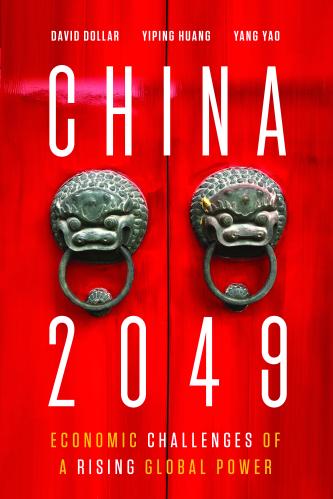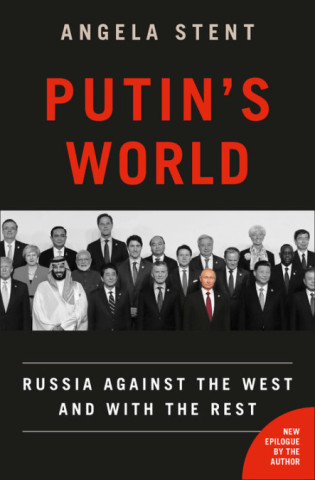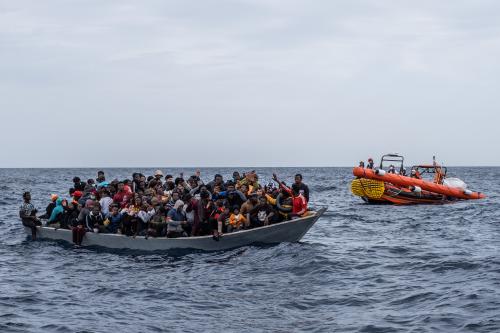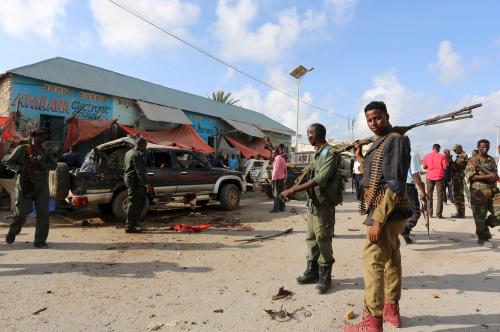The following testimony was submitted to the House of Representatives Homeland Security Subcommittee on Counterterrorism, Law Enforcement, and Intelligence on June 21, 2023, for the “Countering Threats Posed by Nation-State Actors in Latin America to U.S. Homeland Security” hearing and is based on an article by Jessica Brandt and Zack Cooper, “Sino-Russian Splits: Divergences in Autocratic Coercion,” originally published in the Washington Quarterly.
Thank you, Chairman Pfluger, Ranking Member Magaziner, distinguished members of the committee, for inviting me to address you today on the threats posed by nation-state actors in Latin America to U.S. security.
With geopolitical competition resurgent, considerable attention has been paid to Russian and Chinese “playbooks” and authoritarianism more broadly. As has been widely documented, Moscow and Beijing use a suite of low-cost, deniable tools and tactics to conduct influence operations designed to undermine their democratic competitors and make the world safe for illiberalism. They wage these operations using at least four non-military, asymmetric tools: economic coercion, political subversion, information manipulation, and cyber operations.1
Importantly, Russia and China each apply the toolkit differently in Latin America than in their respective home regions. And within Latin America, they operate distinctly from one another, in ways that reflect their unique capabilities and long-term objectives. As I recently argued in the Washington Quarterly, together with the American Enterprise Institute’s Zack Cooper, developing a coherent strategy to push back on Russia and China’s coercive activities in Latin America — and elsewhere — depends on an appreciation of these nuances. Many of the observations in this testimony are drawn from that work.2
Russia takes a different approach to applying the authoritarian toolkit in Latin America than it does in its own region. Within Europe, Moscow endeavors to weaken political leaders and institutions to gain a relative edge over its competitors — in other words, as an end unto itself. In Latin America, Moscow’s influence activities aim to dent the prestige of mostly Western liberal governments and institutions and the political model they represent. Which is to say, its activities are largely instrumental — a means to the ends of eroding cohesion within liberal democracies and among them, and undermining their soft power. Throughout Latin America, the Kremlin works to frustrate relationships between the United States and its partners, deepening relationships with leaders that share Russian President Vladimir Putin’s desire to create alternatives to governance institutions that are dominated by the United States and Europe. As analysts Paul Stronski and Richard Sokolsky have argued, “Moscow hopes to embarrass Washington, and show that it too can make a foray into its main global adversary’s backyard.”3
Throughout Latin America, the Kremlin works to frustrate relationships between the United States and its partners, deepening relationships with leaders that share Russian President Vladimir Putin’s desire to create alternatives to governance institutions that are dominated by the United States and Europe.
Economic coercion
As elsewhere around the world, Russia uses commercial deals, primarily within the energy sector, as an avenue of influence in the region. To bolster Kremlin ally Nicolas Maduro, Russian state-controlled oil firm Rosneft poured roughly $9B into projects in Venezuela between 2010 and 2019. “From the very beginning,” conceded an executive involved in the effort, “it was a purely political project.”4 More recently, in order to build support for its confrontation with Western governments over Ukraine, the Kremlin softened the terms of loans it had made to Cuba worth more than $2 billion. Both countries were among the five that abstained from or declined to participate in a U.N. vote last year denouncing Russia’s brutal invasion.5
Political subversion
Because the Kremlin’s activities in Latin America are designed to strengthen ties with illiberal partners, rather than weaken the cohesion of liberal competitors, the Kremlin does not appear to be focused on undermining democratic political processes in Latin America, as it does closer to home. Moscow has, though, deployed private security contractors linked to the Wagner group to prop up its ally in Caracas in opposition to U.S. interests, and its mercenaries have looked for opportunities to expand their presence in the region, from Haiti to Mexico.6 Russia’s economic and political influence activities in the region are by no means the primary driver of migration to the United States. However, to the extent that they facilitate corruption, make governments less responsive to their citizens, erode the rule of law, and otherwise undermine good governance, they contribute to migration’s root causes.
Information manipulation
Within the information domain, Moscow has made a concerted effort to promote its state media properties online, often with remarkable success. The Twitter account of RT en Español (@actualidadRT) has more followers than RT’s primary English-language account (@RT_com) and is retweeted nearly twice as often. Of the five most frequently retweeted Russian state media and diplomatic accounts on Twitter thus far this year, three target Latin American audiences (@ActualidadRT, @mae_russia, @SputnikMundo).7 Last year, the Russian Ministry of Foreign Affairs’ (MFA) Spanish-language account (@ mae_russia) was more frequently retweeted than its Russian-language one (@MID_rf), even though the latter tweeted more than five times as frequently.8 The same is true on other platforms. On Facebook, RT en Español has more than twice the followers of RT’s English language version and more followers than any other Spanish-language international broadcaster. On TikTok, it is more popular than BBC Mundo, El Pais, Telemundo, and Univision.9
As it wages its unprovoked assault on Ukraine, the Kremlin is putting these assets to use to erode support for Western countermeasures among Latin American publics, where opinion about the conflict appears up for grabs. For months, it blamed Western sanctions for food and fuel shortages affecting the region. “The Russian military operation in Ukraine does NOT threaten the food supply,” argued the Russian MFA on Twitter in Spanish, for example, asserting that the “real reasons” for shortages include “myopic U.S. and European policies” and “illegitimate sanctions against Europe.”10 Spanish is the fourth most spoken language in the world, and Russian content targeting the region could have significant global reach.11
Interestingly, at least within overt space — among state media and diplomats on Twitter, and on state-backed news websites — there is limited apparent evidence that the Kremlin proactively stokes chaos at the border. The top five most retweeted Spanish-language Russian state-backed messages on Twitter covering migration thus far this year offer praise for Mexican President Andrés Manuel López Obrador’s handling of the issue.12 Immigration topics have surfaced in known covert information operations targeting the United States, but that activity seems aimed at weaponizing a politically divisive issue to exacerbate discord.13 Unsurprisingly, some Russian state-backed content focused on immigration boosts domestic criticisms of U.S. policy.14
Cyber operations
In its own region, Moscow conducts cyber operations to punish entities that expose Russian malfeasance, steal information that it can later weaponize in an information operation, and disrupt critical infrastructure, making it more difficult for democracies to govern themselves.15 Because its activities in Latin America primarily aim to foster friendships, there is little evidence that Russia penetrates computer networks to alter or collect data, or to disrupt institutions or political processes in the region.
China, like Russia, takes a different approach to applying the authoritarian toolkit in Latin America than it does in its own region. Closer to home, Beijing has been considerably more assertive in undermining its opponents than elsewhere around the world, including in Latin America, where target countries have at times benefitted from Beijing’s efforts to build influence using positive inducements.
Economic coercion
Boycotts, tariffs, import restrictions, and export quotas — these are among the mechanisms that China has used to coerce its neighbors in response to actions Beijing perceived as undermining its interests, exercising its leverage as the top trading partner of most countries in its home region. In Latin America, by contrast, Beijing is focused on building leverage that it can apply in the future, using the Belt and Road Initiative (BRI) to expand its engagement with more than 20 countries in the region.16 These coercive economic activities foster dependences that make Latin American governments less responsive to their citizens, and therefore undermine good governance. Thus, they too may contribute to the root causes of migration.
Beijing is focused on building leverage that it can apply in the future, using the Belt and Road Initiative to expand its engagement with more than 20 countries in the region.
Political subversion
In Latin America, Beijing uses some of the same political inducements that it does to cultivate influence among China’s neighbors, but with less of an emphasis on direct subversion. China tends to use carrots, rather than sticks, to build sway, using BRI funding as an incentive for states to tow Beijing’s line. This difference primarily stems from the goal of China’s activities in the region: to position itself as helpful to Latin American societies in their battle against hypocritical, overreaching democracies, led by the United States.
Information manipulation
Because China’s ultimate objective is to frame itself as a responsible global power, Beijing’s information operations primarily seek to build a positive view of China and its leadership. In Latin America, as elsewhere, Beijing’s propaganda apparatus promotes narratives that cast democracy as feckless or hypocritical and highlight the strength of its governance model.17 In the global south, during the height of the COVID-19 crisis, Beijing undertook a tailored messaging campaign arguing that its Sinovac vaccine, which does not require cold chain storage, should be the option of first resort.18 In its propaganda targeting overseas audiences, Beijing uses U.S. immigration policy to cast the United States as hypocritical in its advocacy for human rights elsewhere around the world.19 “For a long time, the United States has been giving lessons to other countries on human rights,” China’s People’s Daily recently tweeted in Spanish, “But the way the U.S. treats migrants and refugees at home highlights their hypocrisy on this issue.”20 This is in keeping with Beijing’s strategy of using whataboutism to deflect criticism of its own rights record.
Cyber operations
While in Asia, there is considerable concern about the use of information networks designed and run by Chinese companies, amid concerns that equipment sourced from vendors in China could contain back doors that enable surveillance by Beijing, that is not as much the case in Latin America.21 Within the region, China has provided surveillance systems to at least nine countries, including Argentina, Chile, Brazil, Mexico, and Venezuela.22 To the extent that these systems undermine political and human rights, they too may contribute to the root causes of migration.
Although Putin and Chinese President Xi Jinping work from the same playbook, their approaches reflect their unique capabilities, as well as their distinct goals.23 Moscow and Beijing share certain near-term objectives, but the two are operating on different trajectories and time horizons, with different points of leverage and long-term aims. Russia is a declining power by many measures, which seeks to disrupt the partnerships and institutions of its mostly Western competitor states here and now as a means of gaining relative advantage. With little to lose and perhaps something to gain from exposure, it is not particularly sensitive to attribution for its coercive activities. Seeing the benefits of chaos abroad, its efforts tend to be destructive. China, by contrast, is a rising power with a great deal to lose from having its coercive activities laid bare. It does not seek disorder, but rather a new order more conducive to its interests, and so its efforts to change the status quo have tended to be more patient.24 Both countries are most active in their own regions. For Russia, building influence in Latin America is a means to the end of disrupting Western alliances and institutions. For China, it is a means of building support for Beijing’s way of doing business.
For Russia, building influence in Latin America is a means to the end of disrupting Western alliances and institutions. For China, it is a means of building support for Beijing’s way of doing business.
These nuances carry over into the ways that Russia and China conduct economic coercion in the region. For Russia, this activity leverages its status as a commodity exporter, with energy amounting to half of its exports.25 For China, its coercive economic practices primarily draw on the size of its market, which gives it leverage over trading partners, as well as its relative wealth, which it uses to support friendly politicians.
Russia and China differ significantly in their use of political subversion as well. Moscow’s intelligence agencies are much better equipped at understanding how to influence foreign systems than those of Beijing since the Kremlin has made the use of asymmetric tools a leading component of its foreign policy for decades. The Kremlin has a high tolerance for risk and is comfortable deploying security services abroad. China, by contrast, has less experience with political subversion far afield. To the extent that Chinese operatives have been involved in subversion, they have tended to focus on China’s neighbors.26 But the differences don’t just stem from different capabilities. Political subversion is a tool fitter for Russia’s purposes (undermining the cohesion of democratic societies and their institutions) than China’s (building a new international order).
Russia and China have both conducted information operations targeting audiences in the region, but likewise, in different ways and toward different ends. Where Moscow has a long history of this sort of activity abroad, China is just beginning to experiment with information manipulation far afield. Where Moscow aims to tarnish the appeal of Western systems, China works to position itself as an attractive alternative. Russian state media almost never cover Russia; Chinese state media cover China a great deal.27
The United States needs a strategy for pushing back on Russia and China’s asymmetric activity in Latin America. It should reflect these nuances, be rooted in the United States’ own considerable asymmetric advantages, and uphold democratic values, recognizing that those values are strengths. To that end, there are numerous steps that Washington can take to position the United States for success. Let me propose three.
First, recognizing the range and reach of Russia’s manipulation activity in Latin America, Washington should focus attention and resources on public diplomacy in the region. Concerns over terrorism and resurgent geopolitical competition have driven attention to the Middle East and Asia. As a result, U.S. public diplomacy financing overseen by the State Department has deprioritized the Western Hemisphere.28 Washington could make new investments in entities like Voice of America (VOA) targeted at Spanish language audiences. Of the 12 overseas bureaus currently operated by VOA, none are in Latin America.29 This should change. Such an approach could also include ensuring that the Global Engagement Center is optimally equipped to track Russian information manipulation activity in Latin America. There are more than 40 million Spanish speakers in the United States and U.S. security interests are directly tied to events in the region. Washington cannot afford to cede the information environment to its competitors.30
Second, Washington should conduct messaging campaigns grounded in truthful information to highlight the failures of repression to audiences in Latin America. These campaigns could build on the success of the administration’s novel strategy of downgrading intelligence related to the war in Ukraine to shape how it is perceived.31 They could call attention to the fact that although Russia and China position themselves as “anti-imperialist” and “anti-colonial” powers, both are pursuing expansionist foreign policies. They might also highlight the costs of China’s BRI to the region. Many publics have soured on the environmental destruction and unsustainable debt that too often come along with Chinese investments.32 Many of the region’s recipient countries are democracies and drawing attention to those shortcomings can better inform their voters. Doing so is in keeping with a strategy of exploiting Putin and Xi’s weaknesses, recognizing their fragility to open information.
Third, Washington must equip itself to see across the full threat picture, recognizing that Russian and Chinese coercive activities in Latin America and elsewhere are multidimensional. It is good, then, that Congress established a Foreign Malign Influence Center (FMIC) within the Office of the Director of National Intelligence to consolidate analysis of adversary use of all four tools of interference. It is also good that FMIC appears to be resourced to look at the full range of threats, which, as I and others have documented, go beyond elections.33 As it undertakes its work, FMIC should aim to cut across traditional stovepipes within government and share information where appropriate and feasible with private sector partners and the public.
As it does all of this, Washington should coordinate with partners and allies to share best practices, standing shoulder to shoulder with other democratic societies to counter foreign interference threats. Ultimately, this is a contest over principles, and Washington’s strong network of partners is perhaps its greatest advantage.
Distinguished members, by drawing on a sophisticated picture of the complex ways that Russia and China deploy coercive tools in Latin America and taking these steps that flow from it, Washington can position itself to protect its interests and the American people.
-
Footnotes
- For definitions, see: Authoritarian Interference Tracker, Alliance for Securing Democracy, https://securingdemocracy.gmfus.org/toolbox/authoritarian-interference-tracker/#methodology.
- Jessica Brandt and Zack Cooper, “Sino-Russian Splits: Divergences in Autocratic Coercion,” The Washington Quarterly 45, no. 3, (October 2022): 23-46, https://doi.org/10.1080/0163660X.2022.2124016.
- Paul Stronski and Richard Sokolsky, “The Return of Global Russia: An Analytical Framework,” Carnegie Endowment for International Peace, December 14, 2017, https://carnegieendowment.org/2017/12/14/return-of-global-russia-analytical-framework-pub-75003.
- Christian Lowe and Rinat Sagdiev, “How Russia sank billions of dollars into Venezuelan quicksand,” Reuters, March 14, 2019, https://www.reuters.com/investigates/special-report/venezuela-russia-rosneft/.
- Others included Bolivia, El Salvador, and Nicaragua. Resolution A/RES/ES-11/1, “Aggression against Ukraine: resolution / adopted by the General Assembly,” United Nations, 2022, https://digitallibrary.un.org/record/3959039.
- Andrew Roth, “Russian mercenaries reportedly in Venezuela to protect Maduro,” The Guardian, January 25, 2019, https://www.theguardian.com/world/2019/jan/25/venezuela-maduro-russia-private-security-contractors; Maria Tsvetkova and Anton Zverev, “Exclusive: Kremlin-linked contractors help guard Venezuela’s Maduro,” Reuters, January 25, 2019, https://www.reuters.com/article/us-venezuela-politics-russia-exclusive/exclusive-kremlin-linked-contractors-help-guard-venezuelas-maduro-sources-idUSKCN1PJ22M; Dan De Luce, “Leaked documents: Russian Wagner Group mercenaries look for business close to U.S.,” NBC News, April 12, 2023, https://www.nbcnews.com/politics/national-security/leaked-documents-russian-wagner-group-mercenaries-haiti-rcna79440; Erin Banco, Sarah Anne Aarup, and Anastasiia Carrier, “Inside the stunning growth of Russia’s Wagner Group,” Politico, February 18, 2023, https://www.politico.com/news/2023/02/18/russia-wagner-group-ukraine-paramilitary-00083553.
- Hamilton 2.0 Dashboard, Alliance for Securing Democracy, German Marshall Fund, https://securingdemocracy.gmfus.org/hamilton-dashboard/.
- Jessica Brandt and Valeria Wirtschafter, “Working the Western Hemisphere,” (Washington, DC: The Brookings Institution, December 2022), https://www.brookings.edu/research/working-the-western-hemisphere/.
- Jessica Brandt, statement to the United States Senate Foreign Relations Subcommittee on State Department and USAID Management concerning “The Global Information Wars: Is the U.S. Winning or Losing?”, May 3, 2023, https://www.foreign.senate.gov/download/05/04/2023/050323_brandt_testimony.
- Cancillería de Rusia (@mae_rusia), Twitter, June 21, 2022, https://twitter.com/mae_rusia/status/1539328510627553280; RT en Español (@ActualidadRT), Twitter, June 6, 2022, https://twitter.com/ActualidadRT/status/1533947341811638272. For additional sample content see Brandt and Wirtschafter, “Working the Western Hemisphere.”
- Brandt & Wirtschafter, “Working the Western Hemisphere.”
- RT en Español (@ActualidadRT), Twitter, May 6, 2023, https://twitter.com/i/web/status/1654737760018898944; RT en Español (@ActualidadRT), Twitter, May 6, 2023, https://twitter.com/i/web/status/1654828357140336644.
- S. Rept. 116-290 – Russian Active Measures Campaigns and Interference in the 2016 U.S. Election, Volume II, United States Senate, June 20, 2023, https://www.congress.gov/congressional-report/116th-congress/senate-report/290/1; “Senate Intel Committee Releases Bipartisan Report on Russia’s Use of Social Media,” Press Release, U.S. Senate Select Committee on Intelligence, October 8, 2019, https://www.intelligence.senate.gov/press/senate-intel-committee-releases-bipartisan-report-russia%E2%80%99s-use-social-media.
- Svetlana Ekimenko, “Texas’ Greg Abbott Slams ‘Hypocrite-in-Chief’ Biden After WH Dubs Migrant Transport ‘Illegal Stunt,’” Sputnik International, September 16, 2019, https://sputnikglobe.com/20220916/texas-gov-abbott-slams-hypocrite-in-chief-biden-after-wh-calls-migrant-bussing-illegal-stunt–1100838329.html; RT en Español (@ActualidadRT), Twitter, May 11, 2023, https://twitter.com/i/web/status/1656522016995041280; By Any Means Necessary on Radio Sputnik (@bamnecessary), Twitter, May 11, 2023, https://twitter.com/i/web/status/1656842317758693377.
- Jessica Brandt and Torrey Taussig, “Europe’s Authoritarian Challenge,” The Washington Quarterly 42, no. 4 (December 2019): 133-153, https://doi.org/10.1080/0163660X.2019.1693099.
- Diana Roy, “China’s growing influence in Latin America,” Council on Foreign Relations, last updated June 15, 2023, https://www.cfr.org/backgrounder/china-influence-latin-america-argentina-brazil-venezuela-security-energy-bri.
- Jessica Brandt, “How Autocrats Manipulate Online Information: Putin’s and Xi’s Playbooks,” The Washington Quarterly 44, no. 3 (September 2021):127-154, https://doi.org/10.1080/0163660X.2021.1970902.
- Bret Schafer, et al., “Influence-enza: How Russia, China, and Iran Have Shaped and Manipulated Coronavirus Vaccine Narratives,” Alliance For Securing Democracy, German Marshall Fund, March 6, 2021, https://securingdemocracy.gmfus.org/russia-china-iran-covid-vaccine-disinformation/.
- Lin Lan, “Whipping migrants shows US human rights hypocritical,” Global Times, September 22, 2021, https://enapp.globaltimes.cn/article/1234865; China News 中国新闻网 (@Echinanews), Twitter, April 28, 2023, https://twitter.com/Echinanews/status/1652129574145097728/photo/1.
- Pueblo En Línea (@PuebloEnLnea), June 9, 2022, https://twitter.com/PuebloEnLnea/status/1534823562699104257.
- Hal Brands, “Huawei’s Decline Shows Why China Will Struggle to Dominate,” Bloomberg, September 19, 2021, https://www.bloomberg.com/opinion/articles/2021-09-19/huawei-s-decline-shows-why-china-will-struggle-to-dominate.
- “AI Global Surveillance Technology,” Carnegie Endowment for International Peace, https://carnegieendowment.org/publications/interactive/ai-surveillance.
- Jessica Brandt and Zach Cooper, “Sino-Russian Splits: Divergences in Autocratic Coercion,” The Washington Quarterly 45, no.3 (October 2022): 23-46, https://doi.org/10.1080/0163660X.2022.2124016.
- Brandt, “How Autocrats Manipulate Online Information”; Jessica Brandt, “Autocratic approaches to information manipulation: A comparative case study,” (Williamsburg, VA: AidData at the College of William & Mary, November 28, 2022), https://www.aiddata.org/publications/autocratic-approaches-to-information-manipulation-a-comparative-case-study.
- “Russia,” Observatory of Economic Complexity, last modified January 2022, https://oec.world/en/profile/country/rus.
- Matt Schrader, “Friends and Enemies: A Framework for Understanding Chinese Political Interference in Democratic Countries,” Alliance for Securing Democracy, German Marshall Fund, April 22, 2020, https://securingdemocracy.gmfus.org/wp-content/uploads/2020/05/Friends-and-Enemies-A-Framework-for-Understanding-Chinese-Political-Interference-in-Democratic-Countries.pdf.
- Brandt, “How Autocrats Manipulate Online Information.”
- Samantha Custer, et al., “Assessing U.S. Historical Strategic Communications: Priorities, Practices, and Lessons from the Cold War through the Present Day,” (Williamsburg, VA: AidData at the College of William & Mary, November 2022), https://docs.aiddata.org/reports/gf01/gf01-02/Assessing-US-Historical-Strategic-Communications-Priorities-Practices-and-Lessons-from-the-Cold-War-through-the-Present-Day.html.
- Brandt, testimony to the United States Senate concerning The Global Information Wars.
- Ibid.
- Jessica Brandt, “Preempting Putin: Washington’s campaign of Intelligence Disclosures is complicating Moscow’s plans for Ukraine,” The Brookings Institution, February 18, 2022, https://www.brookings.edu/blog/order-from-chaos/2022/02/18/preempting-putin-washingtons-campaign-of-intelligence-disclosures-is-complicating-moscows-plans-for-ukraine/.
- Wade Shepard, “How China’s Belt and Road Became A ‘Global Trail of Trouble,’” Forbes, January 29, 2020, https://www.forbes.com/sites/wadeshepard/2020/01/29/how-chinas-belt-and-road-became-a-global-trail-of-trouble/?sh=2bc0da0a443d.
- Foreign Malign Influence Center, 50 U.S.C. §3059, United States Code, https://uscode.house.gov/view.xhtml?req=%28title%3A50+section%3A3059+edition%3Aprelim%29.










Commentary
TestimonyCountering China and Russia’s asymmetric activity in Latin America
June 21, 2023